|
|
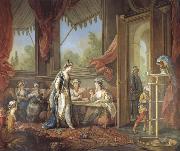 |
Charles Amedee Philippe Van Loo
|
|
French Painter, 1719-1795, was a French painter of allegorical scenes and portraits. He studied under his father, the painter Jean-Baptiste van Loo, at Turin and Rome, where in 1738 he won the Prix de Rome, then at Aix-en-Provence, before returning to Paris in 1745. He was invited to join the Academie Royale de Peinture et de Sculpture in 1747, and that year he married his cousin Marie-Marguerite Lebrun, daughter of the painter Michel Lebrun (died 1753). Among his brothers were the painters Francois van Loo (1708-1732) and Louis-Michel van Loo (1707-1771). |
|
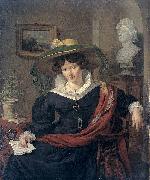 |
Charles Van Beveren
|
|
Charles van Beveren, born at Mechlin in 1809, was instructed in the rudiments of art in the academy of his native city and at Antwerp. He settled in Amsterdam in 1830, subsequently visiting Paris, Rome, and other cities of Italy, and distinguished himself as a painter of history, genre, and portraits. He died at Amsterdam in 1850. The best known of his works are:
The Confession of a Sick Girl (in the Pinakothek at Munich).
Male Figure. A study (in the Rotterdam Museum).
The Vision of St. Ignatius.
The Death of St. Anthony of Padua (in the church of Moses and Aaron at Amsterdam, his chef-d'oeuvre). |
|
|
|
|
|
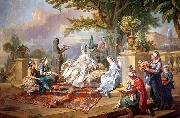 |
Charles-Amedee-Philippe van Loo
|
|
(25 August 1719 -15 November 1795) was a French painter of allegorical scenes and portraits.
He studied under his father, the painter Jean-Baptiste van Loo, at Turin and Rome, where in 1738 he won the Prix de Rome, then at Aix-en-Provence, before returning to Paris in 1745. He was invited to join the Academie Royale de Peinture et de Sculpture in 1747, and that year he married his cousin Marie-Marguerite Lebrun, daughter of the painter Michel Lebrun (died 1753).
Among his brothers were the painters François van Loo (1708-1732) and Louis-Michel van Loo (1707-1771).
|
|
|
|
|
|
|
|
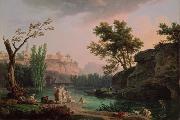 |
Claude Joseph Vernet
|
|
Claude-Joseph Vernet (14 August 1714 - 3 December 1789) was a French painter. His son, Antoine Charles Horace Vernet, was also a painter.
Vernet was born in Avignon. When only fourteen years of age he aided his father, Antoine Vernet (1689-1753),[1] a skilled decorative painter, in the most important parts of his work. The panels of sedan chairs, however, could not satisfy his ambition, and Vernet started for Rome. The sight of the sea at Marseilles and his voyage thence to Civitavecchia (Papal States' main port on the Tyrrhenian Sea) made a deep impression on him, and immediately after his arrival he entered the studio of a marine painter, Bernardino Fergioni.
Slowly Vernet attracted notice in the artistic milieu of Rome. With a certain conventionality in design, proper to his day, he allied the results of constant and honest observation of natural effects of atmosphere, which he rendered with unusual pictorial art. Perhaps no painter of landscapes or sea-pieces has ever made the human figure so completely a part of the scene depicted or so important a factor in his design. In this respect he was heavily influenced by Giovanni Paolo Panini, whom he probably met and worked with in Rome. Vernet's work draws on natural themes, but in a way that is neither sentimental or emotive. The overall effect of his style is wholly decorative.[2] "Others may know better", he said, with just pride, "how to paint the sky, the earth, the ocean; no one knows better than I how to paint a picture". His style remained relatively static throughout his life. His works' attentiveness to atmospheric effects is combined with a sense of harmony that is reminiscent of Claude Lorrain. |
|
 |
claude vignon
|
|
Claude Vignon (19 May 1593 - 10 May 1670) was a leading French painter and engraver working in the Baroque manner.
He was born at Tours and received early training in Paris. About 1610 he travelled to Rome where his mature style was formed in the circle of French painters there that included Simon Vouet and Valentin de Boulogne, a prominent member of the Caravaggisti working, like Bartolomeo Manfredi, in the manner established by Caravaggio.
He returned from Italy, after a tour in Spain, in 1623. His paintings are represented in most of the major museums. |
|
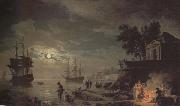 |
Claude-joseph Vernet
|
|
French Painter, 1714-1789
Vernet probably received his first lessons in painting from his father, Antoine, who then encouraged him to move to the studio of Philippe Sauvan (1697-1792), the leading master in Avignon. Sauvan supplied altarpieces to local churches and decorative works and mythologies for grand houses in the area. After this apprenticeship Vernet worked in Aix-en-Provence with the decorative painter Jacques Viali ( fl 1681- 1745), who also painted landscapes and marine pictures. In 1731 Vernet independently produced a suite of decorative overdoors for the h?tel of the Marquise de Simiane at Aix-en-Provence; at least two of these survive (in situ) and are Vernet's earliest datable landscapes. These are early indications of his favoured type of subject, and Vernet would have studied works attributed to such 17th-century masters as Claude Lorrain, Gaspard Dughet and Salvator Rosa in private collections at Aix and Avignon. Three years later Joseph de Seytres, Marquis de Caumont, who had previously recommended Vernet to the Marquise de Simiane, offered to sponsor a trip to Italy. |
|
|
|
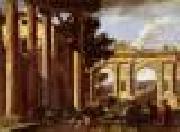 |
CODAZZI, Viviano
|
|
Italian Baroque Era Painter, 1604-1670
Italian painter. He arrived in Naples about 1634, having almost certainly trained in Rome. He was a specialist in the realistic architectural VEDUTA, and his interest in this theme may have been stimulated in Rome by the quadratura frescoes of Agostino Tassi and by the urban views of Claude Lorrain and Herman van Swanevelt. |
|
|
|
|
|
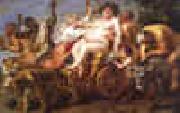 |
Cornelis de Vos
|
|
1585-1651
Flemish
Cornelis de Vos Gallery
Flemish portrait and figure painter. He was a contemporary of Rubens, who sent many sitters to him. Although of the school of Rubens, Vos developed an individual style of portraiture in which cool grays predominate. His representations of children were particularly successful. An example of his many portraits is that of Abraham Grapheus (Antwerp). His brother, Paulus de Vos, c.1596?C1678, was an excellent painter of animals and hunting scenes. His paintings show the influence of his brother-in-law, Frans Snyders. His work is best seen in the museums of Madrid and St. Petersburg. |
|
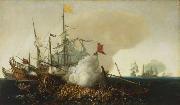 |
Cornelis Hendriksz Vroom
|
|
(1591, Haarlem - buried September 16, 1661, Haarlem) was a Dutch Golden Age landscape painter.
According to the RKD he was the son of the painter Hendrick Cornelisz Vroom, the older brother of Frederick and Jacob, and the father of the painter Jacob Cornelisz Vroom.[1] He became a member of the Haarlem Guild of St. Luke in 1634.
According to Houbraken in 1718, who repeated a list of names from Theodorus Schrevelius's 1648 book on Haarlem called Harlemias, he was the son of Hendrick Cornelisz Vroom and a good landscape painter of Haarlem along with "Joh. Jakobsz.", who was in Italy for many years, "Nicol. Zuyker", Gerrit Claesz Bleker, Salomon van Ruysdael, and Reyer van Blommendael. |
|
 |
Cornelis Janssens van Ceulen
|
|
(also Cornelius Jonson van Ceulen, Cornelius Johnson, Cornelis Jansz. van Ceulen and many other variants)(bapt. October 14, 1593, London - bur. August 5, 1661, Utrecht) was an English painter of portraits of Dutch or Flemish parentage. He has been described as "one of the most gifted and prolific portrait painters practising in England during the 1620s and 1630s".
Janssens van Ceulen was born to Dutch or Flemish parents in London - his father had been a refugee from Antwerp, and the family had originated in Cologne. He was baptised at the Dutch church at Austin Friars, the son of Johanna le Grand and Cornelius Johnson. He may have been trained in the Netherlands, and was certainly influenced by other artists from the Netherlands, but he was active in England, at least from 1618 to 1643. In the 1620s, he lived and had his studio in Blackfriars, London, as did Anthony van Dyck; it was just outside the boundaries of the City of London, and so avoided the monopoly in the City of members of the London painters' Guild. He married Elizabeth Beke of Colchester in 1622. Janssens' son (Cornelius Janssens, junior) was born in 1634. He was also a painter. Janssens' daughter was married to Nicholas Russell of Bruges. Janssens moved to Canterbury in the mid 1630s, living with Sir Arnold Braems, a Flemish merchant. Janssens continued to live in England until after the outbreak of the English Civil War, but in October 1643, apparently at the insistence of his wife, he moved to Middelburg, and between 1646 and 1652 he lived in Amsterdam, before settling in Utrecht, where he was buried. |
|
|
|
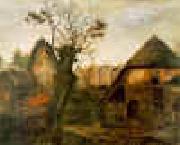 |
Cornelis van Dalem
|
|
1535-1576
Dutch
Cornelis van Dalem Location
Flemish painter. He was the son of a well-to-do cloth merchant living in Antwerp, but of Dutch origin. Cornelis received a humanistic education. His father, who owned land in Tholen, as a vassal to the Counts of Holland and Zeeland, was dean of the chamber of rhetorics De Olijftak (The Olive Branch) in Antwerp in 1552-3. According to van Mander, Cornelis was himself learned in poetry and history and only painted as an amateur, not for a living. Documents in the Antwerp archives invariably refer to him as a merchant, never as a painter, which no doubt accounts for the small number of known paintings by him. He learnt to paint with an otherwise unknown artist, Jan Adriaensens, who had also taught his older brother Lodewijk van Dalem ( fl 1544-85). The latter was inscribed as a pupil in 1544-5 and became a master in the guild in 1553-4. Cornelis was himself inscribed a year after his brother, and he became a master in 1556, the same year he married Beatrix van Liedekercke, a member of an Antwerp patrician family. They lived in Antwerp until late 1565, when, apparently for religious reasons, they left for Breda, together with the artist mother, who had become a widow in 1561. In 1571 several local witnesses testified that van Dalem, who was then living in a small castle, De Ypelaar, in Bavel, near Breda, was strongly suspected of being a heretic. He was never seen in church and was said, on the contrary, to have often attended Protestant services and to have publicly expressed contempt for Papists. |
|
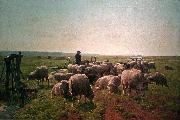 |
Cornelis Van Leemputten
|
|
(1841-1902) was a Belgian painter.
Born in Werchter, Cornelius van Leemputten is predominantly known for his landscapes with sheep, similar to the style of Charles Jacque. He began his painting career without formal training. He was well-known for his barnyard subjects. Leemputten eventually became a pupil of the Academy of Antwerp, though his style remained primarily self-taught.
Van Leemputten participated across several international exhibitions and received gold medals in Ghent in 1883, Edinburgh in 1886, Port Adelaide in 1887 and in Berlin in 1896. In 1895, he received the Knight of the Order of Leopold (Belgium).
|
|
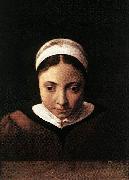 |
Cornelis van Poelenburch
|
|
(1594 - 12 August 1667) was a Dutch Golden Age landscape painter.
Though his birthplace is unknown, a signed document survives in Utrecht where he is listed as six years old and the son of Simon van Poelenburch, a Catholic canon in Utrecht.He initially trained with Abraham Bloemaert, and his earliest signed paintings are from 1620.He traveled to Rome where he was influenced by Adam Elsheimer and became a founding member of the Bentvueghels. He counted a few cardinals under his patrons, and was called to England by Charles I of England, for whom he made small cabinet pieces. He returned to Utrecht where he later died just a few years after his old teacher Abraham Bloemaert.He painted mostly small landcapes with mythical or religious figures or passages, in a style that would later be evident in some of the works of Claude Lorraine.
His "most important and successful" pupils were Daniël Vertangen, Dirck van der Lisse, François Verwilt, and Jan van Haensbergen. Arnold Houbraken claimed that his best pupil was Joan vander Lis from Breda (not Dirk vander Lis from The Hague). Houbraken then mentioned Vertangen, Verwilt, Warnard van Rysen from Bommel, and Willem van Steenree, a nephew. The RKD also mentions Laurens Barata. |
|
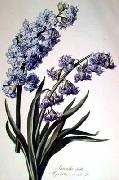 |
Cornelis van Spaendonck Prints
|
|
Dutch 1756-1840
Cornelis van Spaendonck (7 December 1756 - 22 December 1839) was a Dutch painter who was a native of Tilburg. Spaendonck initially worked under artist Guillaume-Jacques Herreyns (1743-1827) in Antwerp, and in 1773 moved to Paris to study and work with his brother, floral painter G??rard van Spaendonck (1746-1822). From 1785 to 1800, Cornelis van Spaendonck was head of the porcelain works at S??vres. Due to difficulties encountered as an administrator, he was relieved of his directorship in 1800, but remained at S??vres as a designer and artist until 1808.
In 1789 Spaendonck became a member of the Acad??mie des Beaux Arts. He painted throughout his lifetime, and displayed his works at the Salons of Paris until 1833. Most of Spaendonck's works were created with oils and gouache, and he is remembered for his lush still-lifes of flowers. Among his paintings were subjects such as De Fleurs Et Fruits, Vase De Fleurs, Bouquet De Different Fleurs, Fleurs Du Jardin, Corbeille Fleurs, et al. At his death in 1840 there were 29 paintings in his studio, which were auctioned soon afterwards. |
|
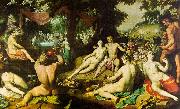 |
Cornelisz van Haarlem
|
|
1562-1638
Dutch
Cornelisz van Haarlem Galleries
Dutch painter and draughtsman. He came from a wealthy family. During the Spanish siege and occupation of Haarlem (1572-7), his parents moved elsewhere, leaving their son and large house in the protection of the painter Pieter Pietersz. (1540/41-1603), who became Cornelis's teacher. In 1579 Cornelis travelled to France by sea, but the journey terminated at Rouen because of an outbreak of plague. He then became a pupil of Gillis Congnet in Antwerp, with whom he stayed for one year. In 1580-81 he returned permanently to Haarlem, and in 1583 he received his first official commission from the city, a militia company portrait, the Banquet of the Haarlem Civic Guard (Haarlem, Frans Halsmus.). Around 1584 he befriended Hendrick Goltzius and Karel van Mander, with whom he is said to have established a kind of academy. |
|
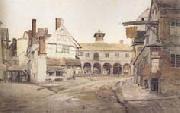 |
Cornelius Varley
|
|
English Painter, 1781-1873
Painter, draughtsman and printmaker, brother of (1) John Varley. Primarily a scientist, he painted watercolours for pleasure. He was less prolific than his brother. Although he was also a founder-member of the Society of Painters in Water-Colours, he exhibited few watercolours there from 1805 to 1820 and even fewer at the Royal Academy and the Society of British Artists between 1820 and 1859 and 1826 and 1844 |
|
|
|
 |
CRIVELLI, Vittorio
|
|
Italian painter, Venetian school (b. ca. 1440, Venezia, d. 1501/2, Venezia) |
|
|
|
|
|
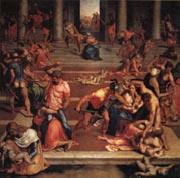 |
Daniele Da Volterra
|
|
Italian Mannerist Painter and Sculptor, 1509-1566
Italian painter, stuccoist and sculptor. Much of the fascination of his career resides in the development of his style from provincial origins to a highly sophisticated manner, combining the most accomplished elements of the art of Michelangelo, Raphael and their Mannerist followers in a distinctive and highly original way. He provided an influential model for numerous later artists in Rome. |
|
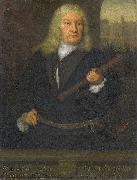 |
David van der Plas
|
|
David van der Plas (1647-1704), was a Dutch Golden Age portrait painter.
David van der Plas became famous as a portrait painter, and his most illustrious patron was Cornelis Tromp. In 1684 he married Cornelia van der Gon of Haarlem, the daughter of the castellan (kastelein) of the Oude Doelen, the meeting quarters of the Haarlem schutterij (the building currently houses the Stadsbibliotheek Haarlem). David van der Plas' brother-in-law was the painter Govert van der Leeuw and his pupil was Jacob Appel.
His wife Cornelia van der Gon was the rich heiress of the Amsterdam architect Adriaan Dortsman (ca. 1636-1682), who designed the round Lutheran church on the Singel. The marriage was childless, and Cornelia spent her time on her doll houses, which Dortsman had helped design and which Van der Plas helped decorate. The landscape painter Jan Wijnants also painted miniatures for these doll houses. Cornelia died in 1701, and after the death of Van der Plas, the doll houses were sold at auction to Sara Rothe, who used them to decorate her own doll houses. |
|
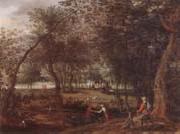 |
David Vinckboons
|
|
Flemish Baroque Era Painter, 1576-ca.1632
was a Dutch painter of Flemish origin. Vinckboons was one of the most prolific and popular painters and print designers in the Netherlands. Himself influenced by Pieter Bruegel the Elder, he was instrumental together with "Hans Bol and Roelant Savery" in the development of genre painting in the northern Netherlands. The family moved to Antwerp around 1580, and then to Middelburg after the Spanish occupation of Antwerp in 1585. It is not likely they moved for religious reasons to Amsterdam. His father became a citizen in 1591, but none of his grandchildren were baptized in a Calvinist church. In 1602 David married in Leeuwarden to Agneta van Loon, the daughter of a notary. Then he lived in Sint Antoniesbreestraat like many other artists and painters. According to Karel van Mander he did not have any teacher other than his father Phillipe, a painter on canvas with watercolors, an art form practised mainly in his birthplace of Mechelen. David specialized in elegant figures in park-like landscapes (Outdoor Merry Company, 1610; Vienna, Akademie der Bildenden Kenste) as well as Kermis and other village festivals. His landscapes reflect his contact with Gillis van Coninxloo. Vinckboons attracted a number of students; among them were Gillis d'Hondecoeter, Claes Janszoon Visscher and probably Esaias van de Velde. |
|
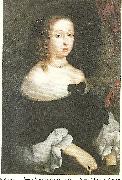 |
david von krafft
|
|
David von Krafft, konstnär, målare, född 1655 i Hamburg, död 1724 i Stockholm.
David von Krafft blev kallad till Sverige 1675 av hofkonterfejaren (hovmålaren) David Klöcker Ehrenstrahl, som dessutom var hans morbror och nu även blev hans lärare i den ädla konsten att måla. Senare studerade von Krafft vidare ett tiotal år i utlandet, särskilt i Italien, slutligen blev han Ehrenstrahls ersättare som hovmålare.
Nu fick han en massa beställningar och uppdrag och han målade sakliga och säkert tecknade porträtt, som tyvärr dock är ganska entoniga och kalla i koloriten. Bland hans bästa arbeten är porträttet av Karl XII (finns i Lund) samt av Carl Gustaf Armfeldt d.ä. (Drottningholms slott). I Kalmar domkyrka har han målat altartavlan (dock efter en komposition av en italiensk konstnär).
David von Krafft finns representerad vid Nationalmuseum, Malmö Museum, Göteborgs konstmuseum och på Gripsholm. Krafft hade ett stort antal lärjungar och bland dem Gustaf Lundberg och Olof Arenius. |
|
|
|
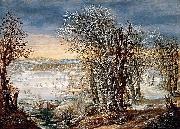 |
Denis van Alsloot
|
|
(Dutch: Denijs van Alsloot) (c. 1570, Mechelen - c. 1626) was a Flemish Baroque painter.
He initially painted using the style of Gillis van Coninxloo, but after 1610 gradually developed a style of his own. This style can be seen in paintings such as The feast of the Ommegang (Museo del Prado, Madrid) and Procession to Mary at the Zavel in Brussels (Victoria and Albert Museum, London).
At the beginning of the 17th century, in either 1600 or 1606, his career rose when he served as court painter to Albert and Isabella.
Hendrick de Clerck sometimes painted the people (Dutch: stoffering or stoffage) in his landscape works.
Van Alsloot's work can be regarded as a precursor to modern Landscape art.
|
|
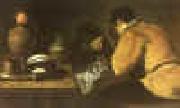 |
Diego Velazquez
|
|
Spanish Baroque Era Painter, 1599-1660
Spanish painter. He was one of the most important European artists of the 17th century, spending his career from 1623 in the service of Philip IV of Spain. His early canvases comprised bodegones and religious paintings, but as a court artist he was largely occupied in executing portraits, while also producing some historical, mythological and further religious works. His painting was deeply affected by the work of Rubens and by Venetian artists, especially Titian, as well as by the experience of two trips (1629-31 and 1649-51) to Italy. Under these joint influences he developed a uniquely personal style characterized by very loose, expressive brushwork. Although he had no immediate followers, he was greatly admired by such later painters as Goya and Manet |
|
|
|
 |
Dirck van Delen
|
|
1604-1671
Dutch
Dirck van Delen Location
Dutch painter. When he married in 1625 he was a citizen of Middelburg, but he settled in nearby Arnemuiden, where he became master of the toll-house. From 1628 until his death he was almost continually a member of the town council, mostly as burgomaster. He was widowed three times and had at least one son, though no children survived him. The inventory of his estate testifies that he was well-to-do. |
|
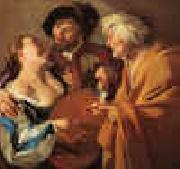 |
Dirck van Baburen
|
|
b.c. 1595, Utrecht, Netherlands.
d.Feb. 21, 1624, Utrecht
Dutch
Dirck van Baburen Gallery |
|
|
|
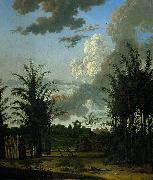 |
Dirk Valkenburg
|
|
(1675, Amsterdam - 1721, Amsterdam), was a Dutch Golden Age painter.
According to the RKD he was a pupil of Michiel van Musscher, Herman van Vollenhove, and Jan Weenix. In 1698 he worked in Vienna for the Prince of Liechtenstein, and from 1706-1707 he travelled to Surinam to draw the native plants and birds for the wealthy city secretary of Amsterdam, Jonas Witsen, who owned a plantation there and whom he met through his teacher Musscher.
He is known for exotic landscapes, paintings of birds, and fruit and flower still lifes. |
|
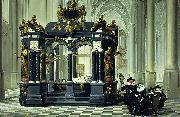 |
Dirk van Delen
|
|
(born ca. 1605 - died May 16, 1671) was a Dutch Golden Age painter.
According to Houbraken, he was born in Heusden, and was a student of Frans Hals. In 1626 he moved to Zeeland and became mayor of Arnemuiden. He specialized in architectural studies.
Shortly after he was born his parents moved to Breda. He married in Middelburg in 1625. Though he is registered in Arnemuiden from the following year until his death, he became a member of the Middelburg Guild of St. Luke from 1639-1665. In 1666 he gave a painting to the Antwerp chamber of rhetoric Olyftak, that was a collaboration with the painter Theodoor Boeyermans. In 1668 he became a member of the Olyftak. The staffage of his baroque churches has at times been attributed to other painters, such as Anthonie Palamedesz, Dirck Hals, and Pieter Codde. He died in Arnemuiden.
|
|
 |
Dirk van der Aa
|
|
Dirk van der Aa , 1731 -- February 23, 1809.
He was born in The Hague, and first apprenticed to Johann Heinrich Keller, and then to Gerrit Mes with whom he would later start a workshop; they specialized in grisaille decorative paintings. He counted Evert Morel, Cornelis Kuipers, Johan Christiaan Roedig and Andries van der Aa amongst his students. He died in his home city of The Hague. |
|
|
|
|
|
 |
Dominique Vivant Denon
|
|
French, 1747-1825,French savant, he accompanied the Napoleonic expedition to Egypt (1798) as leader of the learned Commission on the Sciences and Arts that was to study Ancient Egyptian buildings and architecture and herald the birth of modern Egyptology. In 1802 he published his Voyage dans la Basse et la Haute Egypte pendant les campagnes du general Bonaparte (Journey in Lower and Upper Egypt during the campaigns of General Bonaparte). An accurate source-book of Ancient Egyptian architecture, it had an extraordinary impact, triggering the C19 Egyptian Revival that at first was correctly described as Egyptomania, and was a major influence on Neo-Classicism. Denon was Director-General of Museums, and was in charge of the Musee Napoleon (now the Louvre). |
|
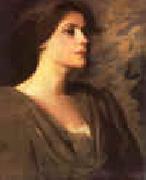 |
Douglas Volk
|
|
1856-1935
Douglas Volk (1856 - 1935) was an American portrait painter and the son of noted sculptor Leonard Volk. He was named after his mother's cousin (Abraham Lincoln's political rival) Stephen A. Douglas. |
|
 |
Edouard Vuillard
|
|
1868-1940
French
Edouard Vuillard Galleries
Jean-Edouard Vuillard, the son of a retired captain, spent his youth at Cuiseaux (Saone-et-Loire); in 1878 his family moved to Paris in modest circumstances. After his father\'s death, in 1884, Vuillard received a scholarship to continue his education. In the Lycee Condorcet Vuillard met Ker Xavier Roussel (also a future painter and Vuillard\'s future brother in law), Maurice Denis, musician Pierre Hermant, writer Pierre Veber and Lugne-Poe. On Roussel\'s advice he refused a military career and entered the Ecole des Beaux-Arts, where he met Pierre Bonnard.
In 1885, Vuillard left the Lycee Condorcet and joined his closest friend Roussel at the studio of painter Diogene Maillart. There, Roussel and Vuillard received the rudiments of artistic training. |
|
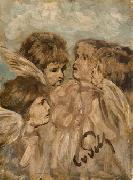 |
Eduard von Gebhardt
|
|
Franz Karl Eduard von Gebhardt (1838-1925) was a Baltic German historical painter. He was born in Järva-Jaani, Estonia, the son of a Protestant clergyman, and studied first at the Academy of St. Petersburg (1855-58). In 1860 he became the pupil of Wilhelm Sohn at Desseldorf, where he permanently settled, and became professor at the academy in 1873. One of his students was the German-Brasilian painter Wilhelm Techmeier.
|
|
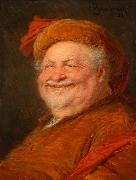 |
Eduard von Grutzner
|
|
(May 26, 1846 - April 2, 1925) was a German painter and professor of art especially noted for his genre paintings of monks.
Gretzner was born in 1846, the youngest of children, into a farming family in Groß-Karlowitz near Neisse, Upper Silesia in what is now Poland. The local pastor often visited his parents' home, as his father was a prominent member of the church. He recognized early on Eduard's talent and inclination for painting. Even as a child he drew on everything that fell into his hands. The administrator of a ducal country house in the neighborhood got him paper, and eventually the pastor gained him entrance to the Gymnasium (a university preparatory school) of Neisse, and brought him in 1864 with the help of an architect Hirschberg for art education at the private school of Herman Dyck in Munich. |
|
|

